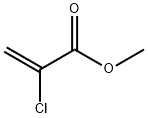Description
Methyl 2-chloroacrylate is a colorless liquid.Molecular weight = 120.54; Boiling point = 52℃ at51 mmHg. Hazard Identification (based on NFPA-704 MRating System): Health 3, Flammability 3, Reactivity 0.Slightly soluble in water; solubility 5 ,1 mg/mL at 22℃.
Chemical Properties
Methyl 2-chloroacrylate is a colorless liquid.
Chemical Properties
clear colorless to pale yellow liquid
Uses
Methyl 2-Chloroacrylate is used as a reagent in various coupling reactions.
General Description
Colorless liquid. Used to make acrylic high polymer with properties closely resembling those of polymethylmethacrylate. Monomer for specialty polymers (e.g., aircraft glazing).
Air & Water Reactions
Insoluble in water.
Reactivity Profile
METHYL ALPHA-CHLOROACRYLATE is sensitive to prolonged exposure to light, moisture and heat. METHYL ALPHA-CHLOROACRYLATE is incompatible with oxidizers and polymerizers.
Health Hazard
METHYL ALPHA-CHLOROACRYLATE is a skin, eye, and lung irritant. The least trace on skin raises large blisters. It is also a respiratory poison; breathing the vapors can cause pulmonary edema.
Fire Hazard
Flash point data for METHYL ALPHA-CHLOROACRYLATE are not available; however, METHYL ALPHA-CHLOROACRYLATE is probably combustible.
Potential Exposure
Used to make acrylic high polymer
with properties closely resembling those of polymethylmethacrylate. Monomer for specialty polymers e.g., aircraft
glazing). Corrosive. Lacrimator.
First aid
If this chemical gets into the eyes, remove any con-tact lenses at once and irrigate immediately for at least15 min, occasionally lifting upper and lower lids. Seek medi-cal attention immediately. If this chemical contacts the skin,remove contaminated clothing and wash immediately withsoap and water. Seek medical attention immediately. If thischemical has been inhaled, remove from exposure, begin res-cue breathing (using universal precautions, including resusci-tation mask) if breathing has stopped and CPR if heart actionhas stopped. Transfer promptly to a medical facility. Whenthis chemical has been swallowed, get medical attention.Give large quantities of water and induce vomiting. Do notmake an unconscious person vomit. Medical observation isrecommended for 24- -48 h after breathing overexposure, aspulmonary edema may be delayed. As first aid for pulmonaryedema, a doctor or authorized paramedic may consideradministering a corticosteroid spray.
storage
Color Code—Red: Flammability Hazard: Store ina flammable liquid storage area or approved cabinet awayfrom ignition sources and corrosive and reactive materials.Color Code—Blue: Health Hazard/Poison: Store in a securepoison location. Prior to working with this chemical youshould be trained on its proper handling and storage. Storein tightly closed containers in a cool, well-ventilated areaaway from oxidizers and reducing agents. Where possible,automatically pump liquid from drums or other storage containers to process containers.
Shipping
UN2929 Toxic liquids, flammable, organic, n.o.s.,
Hazard class: 6.1; Labels: 6.1-Poison Inhalation Hazard,
3-Flammable liquid, Technical Name Required.
Incompatibilities
apor may form explosive mixture with
air. May hydrolyze upon contact with moisture.
Incompatible with nitrates. Methyl 2-chloroacrylate is sensitive to prolonged exposure to light, moisture and
heat. Incompatible with oxidizers (chlorates, nitrates,
peroxides, permanganates, perchlorates, chlorine, bromine,
fluorine, etc.); contact may cause fires or explosions. Keep
away from alkaline materials, strong bases, strong acids,
oxoacids, epoxides, and polymerizers. Compounds of the
carboxyl group react with all bases, both inorganic and
organic (i.e., amines) releasing substantial heat, water and a
salt that may be harmful. Incompatible with arsenic compounds (releases hydrogen cyanide gas), diazo compounds,
dithiocarbamates, isocyanates, mercaptans, nitrides, and
sulfides (releasing heat, toxic, and possibly flammable
gases), thiosulfates and dithionites (releasing hydrogen sulfate and oxides of sulfur). May be a polymerization hazard






